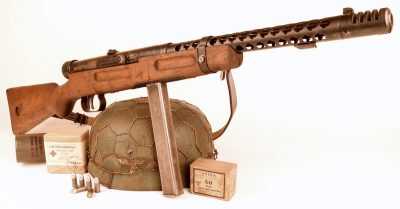
The Beretta Model 38 series of submachine guns might be the one of the most underrated weapons of WWII.
The Second World War was unprecedented in human history. During the course of less than ten years more than fifty million people lost their lives. Nations fell, fortunes were made, and with few exceptions every single person on the planet was affected to one degree or another. As there is no greater motivator than the prospect of gory death or rancid lifelong subjugation, nations raced one another to develop the technology necessary to build weapons with which to either defend themselves or impose their will upon others.
There is a timeless joke about European heaven and European hell. In European heaven the Italians are the cooks, the French are the lovers, the Germans are the engineers, and the English run everything. By contrast, in European hell the English are the cooks, the Germans are the lovers, the French are the engineers, and the Italians run everything. While that silly little axiom may seem esoterically accurate, in one particular area the Italians really outdid themselves during World War II. Their Model 38 submachinegun was the finest pistol-caliber automatic weapon of the war.
Specs
- Chambering: 9mm
- Barrel: 12.4 inches
- OA Length: 37 inches
- Weight: 9.24 pounds
- Stock: Wood
- Sights: Fixed or slide-adjustable open
- Action: Straight blowback
- Finish: Parkerized
Genesis
The Beretta Model 38 was introduced, as the name implies, in 1938. The gun’s formal designation was MAB (Moschetto Automatico Beretta) Modello 1938. This generous mouthful of Italian lexicography literally translates “Beretta Automatic Musket.”
The MAB 38 was the brainchild of one Tullio Marengoni in 1935. The MAB 38 was a direct offshoot of the Villar Perosa, the light machinegun that saw its combat debut in World War 1 as the world’s very first pistol-caliber submachinegun. Interestingly, the similarities are so stark that the prop masters for the Guy Ritchey Sherlock Holmes movie Game of Shadows actually bodged together a handheld facsimile of the Villar Perosa for the film out of a brace of inverted Beretta 38/42 subguns.
Early MAB 38 guns were meticulous products of Old World artisans. Gunmaking in the interwar years arguably reached its zenith in the heady days before computers and automated everything. Demand for these guns in the late 1930’s was such that hand fitting and tedious production could be tolerated. Alas, such frivolities were not destined to last.
Practical Employment
The earliest MAB 38’s were issued to colonial police units vainly attempting to retain Italy’s hold on its occupied colonies in Africa. Subsequent orders came for police units in both the military and civilian police forces, but large-scale military requests were not forthcoming. Thus things languished all the way until 1943.
Before 1943 the MAB 38 was essentially the sole purview of Blackshirts, tank crews, paratroopers, and military police personnel. Like most militaries of that age, the Italian leadership was a grand proponent of the rifle and remained deign to embrace something as unconventional as a pistol caliber automatic weapon. After the Italians capitulated to the Allies in 1943, lots of strange things happened in Italy. Principal among these was that the Italian Army seemed to evaporate. It was coincident that the salient strengths of the MAB 38 submachinegun began to be fully appreciated. In the final years of the war the design was upgraded and mass-produced, finding its way into some unexpected spaces as a result.
Evolutionary Morphology
The early 38A incorporated a solid wood stock and a long perforated barrel jacket replete with bayonet lug. The gun fired from the open bolt and incorporated a novel dual-trigger fire control system. Pressure on the front trigger produced semi-auto fire while pressure on the rear trigger rendered fully automatic. The gun fed from 10, 20, 30, and 40-round magazines and cycled its 9mm Parabellum rounds at around 600 rounds per minute. For some unfathomable reason, the gun ejected out the left. While this feature was not problematic at all it was simply strange.

The 38 had two triggers. The front was for semi-auto fire while the rearward one was for automatic fire.
As the war ground on demand for these superb Italian submachineguns skyrocketed and manufacturing corners were subsequently cut. The complicated perforated barrel shroud was dropped and the stock cut back. The complex floating firing pin assembly of the 38A gave way to a simple dimple machined into the bolt face for the simplified models.
The subsequently bare barrels were fluted for light weight and better cooling though later versions dispensed with these flutes as well. These simplified guns were designated the Beretta 38/42 and 38/44. Though there were minor internal differences, the fluted barrels on the 38/42 versus the smooth tubes on the 38/44 remain the most overt distinguishing feature. While these later guns were indeed lighter and simpler than the original 38A’s, they operated in exactly the same manner. The original long-barreled 38A was liberally incorporated into Axis propaganda iconography in much the same manner as the Nazis used their MP40. A slightly tweaked later model 38/49 with a crossbolt safety equipped post-war forces.
Application
The Beretta 38 family of guns was popular no matter the uniform of those wielding them. Italian partisans preferred the 38 to airdropped British Stens for its greater accuracy and reliability. Captured guns were popular with the Allies as they fired the same 9mm Parabellum rounds used by both the Germans and the British. The Italians actually produced an unusually hot 9mm load specifically for these guns called the Cartuccia 9mm M38 that offered a maximum effective range of 200 meters.
While the Model 38 guns were ultimately used throughout the Italian military services, their most infamous users were the German Waffen SS and Fallschirmjagers. These elite German soldiers coveted the Model 38 and heaped praise upon the gun in all its guises. While the early 38A was indeed a bit longer than most other competing models, the extra barrel length and full stock made for an unusually accurate and effective platform. These features combined with the gun’s slow rate of fire and 40-round box magazines made the weapon formidable in these capable hands.
Comparisons
To appreciate fully the exceptional capabilities of the Italian Model 38 one must also consider the competition. Every major power in World War 2 fielded their own submachinegun designs, and these designs reflected the personalities of the nations producing them. To compare and contrast these guns is to gain a glimpse into the strategic military mindsets of the day.
The German MP40 was itself an evolutionary development of the earlier MP38 and the exceedingly rare MP36. The MP40 was the first stamped steel submachinegun really optimized for mass production. Popular with its users and ubiquitous in its distribution, the MP40 was nonetheless plagued by its substandard magazines. These 32-round boxes carried their rounds in a double column that tapered to a single feed at presentation. As a result, these magazines required a dedicated loader and were more prone to failure than the double column sorts. The MP40 first pioneered the metal folding stock on a military firearm. Around a million copies rolled off the lines before the gun was supplanted by the MP44 assault rifle.
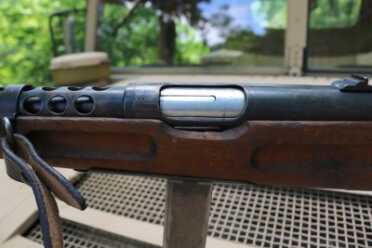
The straight-blowback-operated Model 38 featured a large ejection port to enhance function and reliability.
The American Thompson, iconic though it might have been, was really optimized for the previous war. Functionally obsolete before hostilities even broke out for the Second War to End All Wars, the Thompson was heavy, ungainly, and expensive. Early 1928 models were overly complicated while subsequent M1A1 versions were just boat anchor heavy. The .45ACP round they fired was a proven stopper, but these big guns still fired too fast and weighed too much for easy portage and optimal employment.
The subsequent American M3 Grease Gun was actually an objectively better weapon than the more popular Thompson. The Greaser was far cheaper to build yet comparably reliable. The Grease Gun’s double column/single feed magazine, however, was hard to load and less reliable in action than the double-column version used by the Thompson. The Grease Gun’s sedate rate of fire made the gun exceptionally controllable.
The Russian PPSh was a farm implement of a firearm that was legendarily robust. The zippy bottlenecked 7.62x25mm cartridge it fired was arguably more advanced than any other pistol cartridge of the war. However, the gun’s 71-round drum magazine was overly complicated for optimal widespread employment. Additionally, the gun’s spunky 900-rpm rate of fire burned through ammo alarmingly fast. The PPSh was also notorious for dropping hot cases back on top of your head. Ask me how I know that.
The British Sten was the crudest gun of the lot, but it retained several laudable features. Cheap to produce with a slow and controllable rate of fire, the Sten’s side-mounted magazine made for the best employment from the prone position. While this may not seem like much for the average recreational shooter, for the British Tommy, American Dogface, or German Landser, keeping a low profile in combat meant staying alive. Alas, the Sten suffered from the same crappy magazine issues as did the MP40.
Range Time Ruminations
By contrast to each of these respected subguns, the Beretta Model 38 was exceptionally smooth and controllable. The early long-barreled 38A stays on target with minimal effort even in long bursts. The muzzle brake tends to direct muzzle blast upwards to counteract the tendency of all handheld automatic weapons to climb. The sedate rate of fire coupled with the robust double column 40-round magazine makes the gun run for stupid long times. Doubles and even singles on full auto are easy enough for the disciplined trigger finger, and magazine changes are both fast and intuitive.
The layout of the Beretta 38 in all its forms approximates that of an infantry rifle and lends itself to accuracy as a result. The operator can switch from precise semiauto operation to burst fire instantaneously based solely upon which trigger they squeeze. Early models also incorporate a manual safety lever accessible on the top left aspect of the receiver.
Dropping the ventilated barrel shroud on the 38/42 did little to hamper the gun’s superb design. Firing both the 38A and 38/42 side by side shows the longer 38A to be the more pleasant of the two guns. However, even the late war abbreviated model outshoots all of its international wartime competition. Shocking though it may seem, this relatively obscure Italian design was indeed the finest subgun of the war.
Special thanks to www.worldwarsupply.com for the period replica gear used in the preparation of this article.

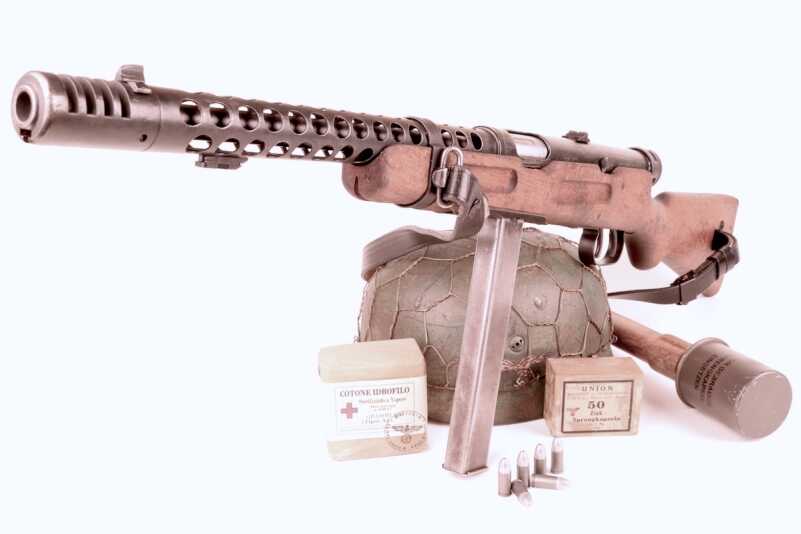
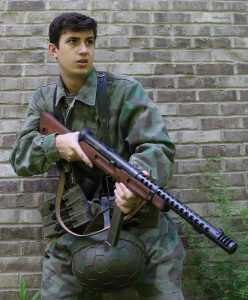

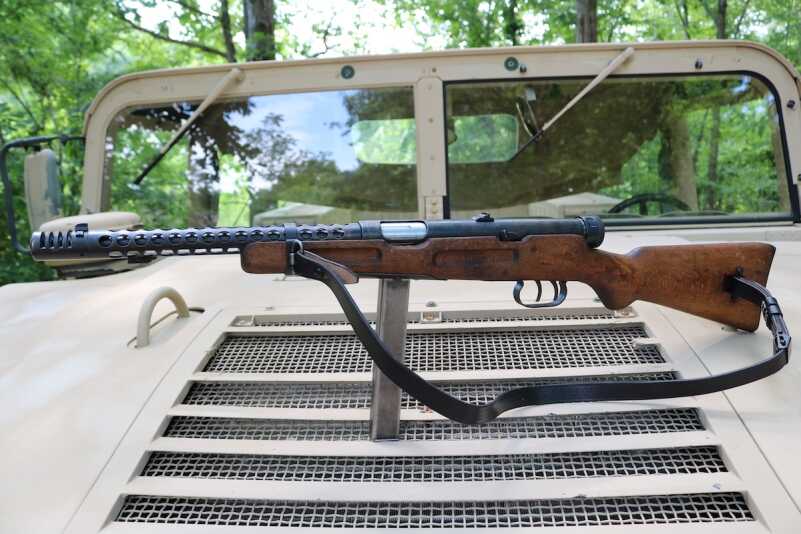


whats is that gun worth
How does it compare to the Suomi KP/-31?
The weapon was a good serviceable SMG but far from the best. Personally I liked the Thompson MI or MIAI and was willing to put up with the weight for its very reliable service and the weight of its round. Then what about the best ? Take the Soumi for a start. It was the father of the PPSH and better than it also. It was one of the most accurate of SMGs. The British had the Landcaster with its 50 round magizine and was sworn by almost every user. Heavy but also reliable and fewer mag problems than most.
My choice of best SMG was adopted by America but never made in any numbers. It was the M2. A bit heavy but at full automatic and at 50 yards would put all the fired rounds in about the size of a baseball. The rear screw cap could be used to adjust the rate of fire from about 350 rounds to upward of 700 rounds. Made with a wooden stock (my favorite) or a crude metal stick not unlike Early Finnish AK copies. I was lucky enough to be given the chance to do a full review on this historical footnote and would have loved to have had one.
Interesting article, personally magazine design is huge, anything double stack and single feed position rates lower on my list.
I actually think the pps43 would give this gun a run for 1st place,
1. Good mags
2. Compactness
3. Impressive cartridge
4. Cheap to build
WISH THEY WOULD MAKE A REPRODUCTION TO SELL.
……yeah, this gun was so great , it alone helped the italians to win the war……
Fortunately these madman ruled countries did not have their acts together regarding procurement
Imagine the Axis if they had the Italians make all the subguns, the Germans had developed the G43 several years earlier, the MP44 sturmgewher several years earlier, built a four engine bomber etc. We were very lucky in WW2. Without four engine bombers and the Garand it may have been very different.
Enjoyable article. Wish America was not so paranoid about sub-guns. I would like to have one of the 38/42’s, but alas the price is beyond even a dream.
I had a chance to fire one of these Beretta’s a few years ago and I was impressed at how controllable it was in full auto. Firing short bursts I could drill the center out of a target at 20 yards. Considering it was built by Beretta, the world’s oldest gunmaker, I was not really surprised at its performance. I would also like to add that on the day I got to shoot it, I fired about 500 rounds total and it never malfunctioned.
An excellent article! Even though it was a SMG, characteristically (-FA) it’s Da Godfather of the current trend in pistol caliber carbines! It great to have these nostalgic yet very informative deversions from the omnipresent MSR this, polymer that, type feed bag. Please bring more like it to the table.
Thank you.